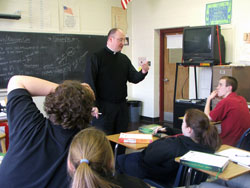Catholic Schools Week Supplement
Centered on Christ:
New curriculum brings unity to high school religion classes

Father Bill Williams, chaplain at Father Thomas Scecina Memorial High School in Indianapolis, speaks with one of his religion classes at the school about vocations on Jan. 15.
(Photo by Sean Gallagher)
By Sean Gallagher
Last fall, the U.S. bishops approved a new religion curriculum framework for Catholic high schools from coast to coast.
The framework establishes a schedule of six required core courses as well as additional elective courses that high schools may offer. Included in the framework are outlines for each course.
According to Kenneth Ogorek, archdiocesan director of catechesis, this effort by the bishops was in large part initiated at the request of textbook publishers.
In the past, some high schools’ curriculums would cover a particular topic in the senior year that others would address in the freshman year.
This made it difficult for publishers to offer textbooks for students at such different learning levels since the market for Catholic high school religion textbooks is relatively small.
However, Ogorek said the bishops were also open to creating the framework because of the importance of forming teenagers in the faith.
“They know, as John Paul II pointed out, that one of our most basic human rights is to hear the Catholic faith proclaimed,” Ogorek said. “And they know that, right now, there probably needs to be a little more unity in that effort.”
Cokie Scheidler, a member of St. Luke the Evangelist Parish in Indianapolis, has sent four of her children to Bishop Chatard High School in the Indianapolis North Deanery and plans on enrolling another child there next fall.
She said that establishing a national framework for high school religious instruction at this time is important because more families move nowadays than in the past.
“As transient as our country seems to be now, with people relocating for jobs, it’s important that [the Church] continue to keep its faith education strong,” Scheidler said. “If it’s standardized when you go from state to state, you wouldn’t have any type of issue with that.”
As chaplain of Father Thomas Scecina Memorial High School in the Indianapolis East Deanery, Father Bill Williams is in the classroom teaching religion.
He said that the national unity of the framework also has a theological meaning.
“I think that it is indicative of the Church—it’s universal,” Father Williams said. “ … It allows us to be one in our system of education as the Body of Christ is called to be one.”
The core courses envisioned in the framework are themselves unified because they all are intentionally Christ-centered with such titles as: “The Revelation of Jesus Christ in Scripture,” “Jesus Christ’s Mission Continues in the Church,” and “Sacraments as Privileged Encounters with Jesus Christ.”
Ogorek, who previously taught at two Catholic high schools in Pittsburgh, thinks that focusing the courses on Christ will sharpen students’ understanding of and relationship with him.
“Teens are being exposed to many more different voices, many more different perspectives,” he said. “They hear a lot about what’s important, how we should live, even who Jesus is to some extent. And it’s important for young people to know who Jesus really is and who he isn’t.”
Sarah Chumbley, a senior at Scecina and member of Our Lady of Lourdes Parish in Indianapolis, said making such a focus on Christ intentional would be a good improvement.
“A lot of times, when we’re just learning definitions and stuff and we’re memorizing things that happened, I think we forget that it’s centered around Jesus,” Sarah said. “If everything was focused back on Christ, then it would give us more meaning in it and kind of draw us closer to our faith more.”
Also included in each course will be a section where students will learn how to respond to challenges regarding the Catholic beliefs covered in the curriculum.
“As they take their faith into higher education and the work place, they’re going to encounter challenges to their faith,” Ogorek said. “And, by the same token, they’re going to encounter opportunities to give a reason for their hope.
“That is another thing that I think is beautiful about this framework. At the end of each core course, there is a brief section that helps prepare people for possible challenges to their Catholic faith.”
Ultimately, Father Williams thinks that the new national high school religion curriculum is a response to the desire of teens to learn the faith and will lead them to live it out in their lives.
“I think the teens in our high schools truly want to know the truth of our faith, and are bright enough and curious enough to be open to it and be enriched by it,” Father Williams said. “The ultimate goal is to love God with our entire being, and our neighbor, and to hope in eternal life with him, and I think this curriculum strengthens one in that.” †
